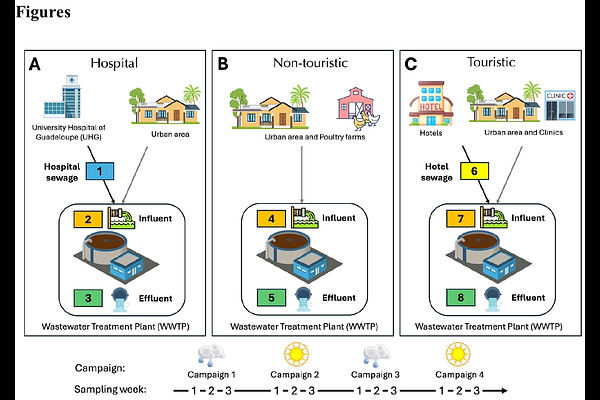Impacts of wastewater treatment and the exposome on antibiotic resistance gene dynamics: Insights from Guadeloupe, a French Caribbean Island

Impacts of wastewater treatment and the exposome on antibiotic resistance gene dynamics: Insights from Guadeloupe, a French Caribbean Island
Alexa, M.; Kovacevic, A.; Pimenta, M.; Batantou Mabandza, D.; Ahmed, I.; Breurec, S.; DAGOT, C.; Huynh, B.-T.; Opatowski, L.
AbstractWastewater treatment plants (WWTPs) are global hotspots for the dissemination of antibiotic resistance genes (ARGs), primarily driven by different anthropogenic activities. Chemical compounds commonly found in wastewater, including antibiotics, biocides, non-steroidal anti-inflammatory drugs (NSAIDs), and heavy metals, along with environmental factors such as temperature and precipitation, might enhance the selection of antibiotic-resistant bacteria (ARB) even at low concentrations, inadvertently promoting the proliferation of ARGs. Since WWTPs can vary in their removal efficiency and influent compositions, it is important to assess their impact in influencing the relative abundance of ARGs and pollutant concentrations in discharged effluent. We analyzed data collected in Guadeloupe, French Caribbean, using random forest and lasso to investigate changes in the resistome and exposome within untreated wastewater influents and treated effluents from three WWTPs. These WWTPs represented three distinct wastewater continuums - hospital-based, urban non-touristic, and urban touristic - each with unique influent compositions. The study, which spanned four sampling campaigns from September 2021 to January 2023, revealed that the reduction in ARG abundance by the WWTPs was lower than expected. Of the 16 clinically relevant genes and mobile genetic elements examined, the relative abundance of aph(3\')-III, blaOXA, blaSHV, blaTEM, ermB, intI1, qnrS, and tetM was reduced by 59.8% to 89.9% across the three WWTPs. An increasing trend in the relative abundance of the mcr-1 gene was observed, showing a 9.52-fold increase in the treated effluent in the hospital continuum. Of the nine antibiotics tested, trimethoprim levels dropped by 70.8% in the touristic continuum and 78.8% in the non-touristic, while ciprofloxacin saw a significant 64.4% reduction only in the touristic continuum, while no other antibiotics or biocides among the eight tested were effectively removed. Regarding heavy metals, significant reductions were observed only in the non-touristic continuum, with cadmium (Cd), copper (Cu), and mercury (Hg) concentrations reduced by 32.5%, 21.1%, and 36.2%, respectively. Our findings provide insights into the associations between environmental factors and the relative abundance of ARGs in Guadeloupe. Generally, depending on the continuum, biocides, the antibiotic erythromycin, certain heavy metals (As, Cd, Cu, Cr, and Hg) and water temperature were associated with the relative abundance of clinically relevant ARGs. This study was not able to assess the impact of climate. Future research should include longitudinal studies with more frequent sampling to better investigate the evolution of antibiotic resistance in bacterial species and its associated drivers, including pollutants and climate-related factors.